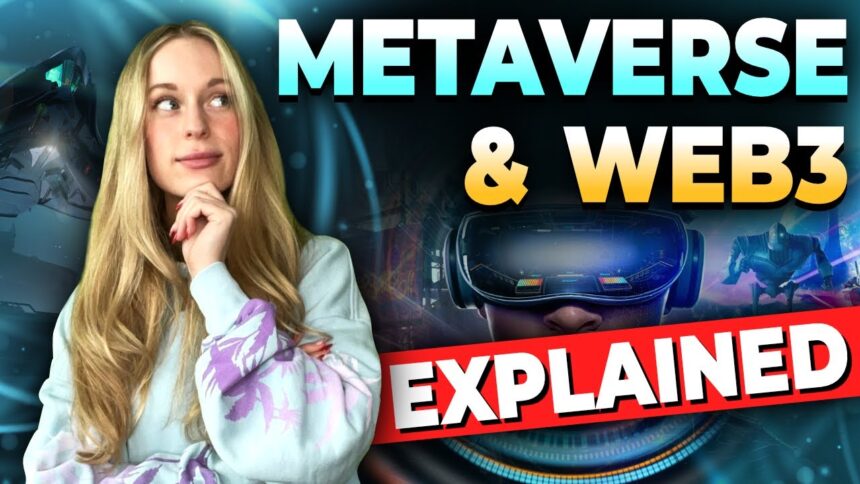For many people, the words Web3 and metaverse sound like sci-fi jargon. This guide breaks both ideas into plain, everyday language. No tech background is needed. By the end, readers will know what Web3 is, what the metaverse is, how they connect, and how to take safe first steps.
The phrase Web3 Metaverse Explained is not just a headline here. It is a promise to keep things simple, honest, and beginner-friendly.
In 2025, Web3 and metaverse projects are growing fast. New virtual worlds, VR headsets, and AI-powered characters are turning the internet into something people can step into, not just stare at on a screen. This guide helps readers make sense of it all before they dive in with their time or money.
Web3 Metaverse Explained in Simple Words
Think about how the internet feels today. Most people use social media, video apps, and game platforms owned by big companies. Those companies control the rules, own the data, and can change or shut things down at any time.
Web3 is the idea of an internet where users share more control. Apps and online spaces can be owned and run by the people who use them, not just a central company.
The metaverse is a network of shared 3D digital spaces. People do not just watch content in those spaces. They enter as avatars, talk, work, learn, play, and even earn money.
So when someone sees “Web3 Metaverse Explained,” it usually means this: Web3 is the tech behind ownership and rules, and the metaverse is where that tech shows up as living, interactive virtual worlds.
For a deeper comparison of how Web3 and the metaverse relate, readers can check out Hedera’s guide on Web3 vs. Metaverse: The Differences and Connections.
What Is Web3 and How Is It Different From Today’s Internet?
A simple way to picture the history of the web is:
- Web1 (roughly the 1990s): People mostly read websites. Like online brochures or news pages.
- Web2 (2000s to today): People read and post. Social media, YouTube, and apps where users create content, but companies hold the data.
- Web3 (starting now): People read, post, and own. Users can own digital items, vote on changes, and share in the value of the platforms they use.
Web3 uses blockchains, which are shared online records. With them, a person can truly own a digital token, a game item, or a piece of virtual land. In some Web3 apps, users can also vote on updates or rules with tokens, which shifts power away from a single owner.
A Web2 example is a photo on a social media account that can be removed at any time. A Web3 example is a digital artwork stored and recorded on a blockchain, where ownership does not depend on one company’s server.
What Is the Metaverse in Daily Life Terms?
The metaverse is often explained as “the next version of the internet,” but that sounds vague. A simpler picture helps.
Imagine a set of connected virtual worlds that feel like a mix of:
- An online game
- A video call
- A social network
- A digital mall or city
In those worlds, people appear as avatars. They can:
- Join concerts and sports events
- Take classes or job training
- Hang out with friends
- Visit virtual offices
- Shop for both digital and real products
It is similar to an online game, but bigger, because real money, jobs, and business exist there. People can buy land, open virtual stores, or host events that charge entry fees.
The metaverse does not require a VR headset. Many platforms work on regular laptops, phones, and tablets. VR just makes the feeling more immersive if someone has the hardware.
For a structured walkthrough of what the metaverse is and how it works, new readers may find value in the Blockchain Council’s step-by-step beginner’s guide to the metaverse.
How Web3 and the Metaverse Fit Together
The easiest way to link them is with a city analogy.
- The metaverse is the virtual city. It has streets, buildings, event halls, and parks.
- Web3 is the system that gives people digital property rights, money, and voting power in that city.
In older online worlds, everything belongs to the company. An account might own a sword, a skin, or a plot of “land,” but the game studio can change or delete it.
In a Web3 metaverse, items can be:
- Tokens or NFTs that live on a blockchain
- Tradeable or usable across different apps
- Controlled by rules that are shared and transparent
Web3 works like the land deed and keys. It says, “This wallet owns this piece of land,” or “This ticket belongs to this person.” Shared digital currencies and NFTs move through these worlds, and the rules can be set by communities, not only by one business.
Key Building Blocks of Web3 for the Metaverse
Several core ideas make Web3 and metaverse platforms possible. These terms might sound complex at first, but each one can be understood with a simple picture.
Blockchain: The Shared Digital Notebook
A blockchain is like a big shared notebook on the internet.
- Everyone can see what is written.
- New pages are added in order.
- Old pages cannot be secretly erased or changed.
In a city, local offices keep public records of who owns which house. In a Web3 metaverse, a blockchain keeps records of who owns what, such as:
- Virtual land
- Rare game items
- Tokens or coins
- Event tickets
Because the notebook is shared across many computers, it is very hard to fake entries. That builds trust without relying on a single central company.
Cryptocurrencies: Money Inside the Metaverse
Cryptocurrencies are digital money that live on a blockchain. They can move quickly between users without a bank in the middle.
Inside Web3 apps and virtual worlds, crypto can be used to:
- Buy outfits or accessories for an avatar
- Pay entry fees for concerts, classes, or clubs
- Tip creators or pay freelancers
- Trade rare game items or collectibles
Prices of cryptocurrencies can change a lot, sometimes within a single day. For that reason, beginners are wise to start small, learn how things work, and never treat early steps as a sure way to “get rich.”
NFTs: Proving Ownership of Digital Stuff
NFT stands for “non-fungible token.” The phrase sounds technical, but the idea is simple: an NFT proves that a specific wallet owns a specific unique digital item.
That item could be:
- A digital artwork
- A music file
- A skin in a game
- A membership pass
- A plot of virtual land
People can copy the picture or file, just like someone can copy a photo of a painting. The NFT is more like a certificate that says who owns the original. The blockchain acts as the gallery record.
Not all NFTs keep their price, and many drop in value. For beginners, it is better to view NFTs as tools for digital ownership, access, and community, not as lottery tickets.
For a broader view of how Web3 tools like NFTs fit into new internet models, this detailed article on Web3 vs Metaverse and how they connect can add extra context.
Smart Contracts: Auto Rules for Digital Deals
Smart contracts are small programs that run on a blockchain. They follow clear, written rules, and once they start, nobody can quietly change them.
In a metaverse setting, smart contracts can:
- Pay a creator each time someone buys their digital outfit
- Send a share of ticket sales to an event host
- Release access to a virtual space after payment arrives
- Distribute rewards to players after a tournament
Think of a vending machine. Someone puts in money, presses a button, and the machine drops a drink. There is no need for a cashier. Smart contracts work in a similar way for digital deals.
DAOs: Online Communities That Make Group Decisions
DAO stands for “decentralized autonomous organization.” Despite the clumsy phrase, the idea is simple: a DAO is a group of people making shared decisions with the help of tokens and voting.
Members of a DAO usually:
- Hold tokens that represent a voice in the group
- Vote on what to build or how to spend shared funds
- Propose ideas and review others
In the metaverse, DAOs can:
- Run virtual cities or neighborhoods
- Manage community-owned game worlds
- Operate clubs, galleries, or music venues
The key idea is shared power instead of a single boss. That does not mean DAOs are perfect, but they do offer a new style of online community leadership.
What People Can Actually Do in the Web3 Metaverse
All of this theory matters only if it leads to real experiences. Today, Web3 metaverse projects already support a wide mix of activities.
In 2025, many platforms will also support AI-driven characters and cross-world standards. That lets players move between different worlds with the same avatar, identity, or items, and talk to non-player characters that feel more lifelike.
Play Games and Earn Digital Rewards
Blockchain games let players earn items or tokens they truly own. These rewards can sometimes be:
- Traded within the game
- Sold on external markets
- Used in other partner games
For example, a player might win a rare sword that exists as an NFT. They can keep it, trade it, or sell it on a Web3 marketplace if the game supports that.
Nothing about these rewards is guaranteed. Some items never find buyers, and many tokens lose value. The healthier mindset is to focus on fun and on the feeling of ownership, not on quick profit.
Attend Virtual Events, Classes, and Meetups
Metaverse platforms now host:
- Concerts and DJ sets
- Tech conferences and expos
- Language lessons and coding classes
- Casual hangouts and fan meetups
NFTs or tokens can act as:
- Tickets to enter the event
- Proof of attendance
- Membership passes to private communities
Someone can attend a live concert with friends from three countries at once, or join a workshop without leaving home. In 2025,















